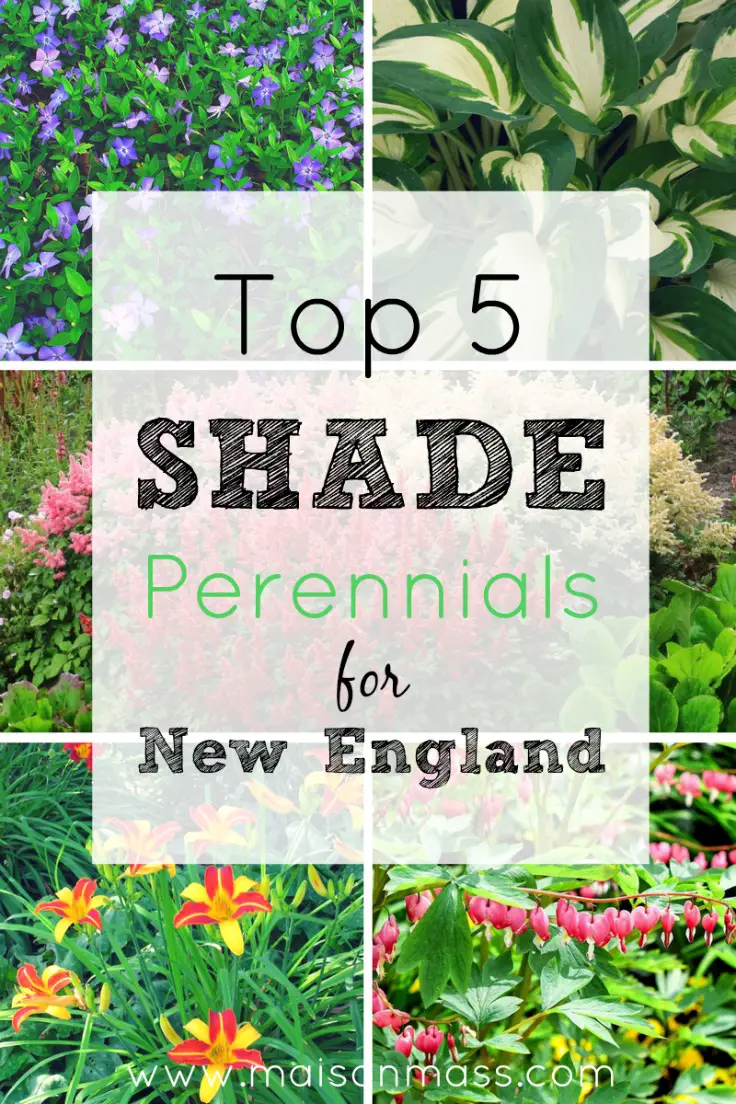The Backstory
I have a flower bed that was created when we put our swimming pool in 10 summers ago. The bed abuts one corner of the pool that is edged with rocks and was designed by our pool contractor to give the pool a more natural feel. The problem is, the bed gets almost no sun.
The obligatory pool fencing was intentionally installed behind a line of burning bushes that were already in the landscape (pre-invasive species ban). The burning bushes hide the chain link fence and provide privacy. They also block nearly all the sun to the bed.
Over the years I’ve tried different plants in the landscape and have usually resorted to planting annuals (impatiens) at the edge of the bed which gets the most sun. The problem is the rest of the bed looks bare, save a few hostas I planted years ago. This year, I decided to finally tackle this bed and find some shade perennials that will do well in this space.
Sun/Shade Classification
First, I needed to understand what the system for describing a plant’s tolerance to sun. There are four basic terms used to describe how much sun a plant needs to optimally thrive: full sun, partial sun, partial shade and full shade. Unfortunately, for the novice, there is no one hard and fast definition of these terms. So pulling from many sources, this is a good summary:
- Full sun: this is defined as six or more hours of direct sunlight a day. I’ve read the sunlight doesn’t have to be continuous, so don’t get hung up on that. You can plant full sun varieties in spots that get some morning sun and some afternoon sun, as long as it all adds up to 6 or more.
- Part sun/Part shade: these both denote 3-6 hours of direct sunlight a day and are sometimes used interchangeably, but there are subtle differences. Partial sun plants can take more direct sunlight than partial shade plants. And they can take more of the hotter, afternoon sun than shade plants can. So, if you have a spot that gets some morning sun – say for 4 hours – then is shaded for the afternoon – a partial shade plant would be a good choice. If the opposite were true, a partial sun plant would fare better.
- Full shade: this means less than 3 hours of sun a day. These are the shade perennials I need for my bed!
The Shade Perennial List
Next, I did some field research. I visited a handful of local nurseries and these were the top recommended picks for shade perennials that also give color and texture to a space:
- Hostas (full shade)

I think of these as the workhorses of any garden bed or path. Originally from China, hostas made their way to the West via Japan to Europe and then on to the United States. Hostas are a hardy perennial that do extremely well in the shade. Did you know hostas are edible? But be careful, as they are toxic to dogs, cats and horses.Hostas come in a myriad of cultivars and enterprising greenhouses are coming up with new varieties seemingly annually. Choices range from foliage color (blue, green, chartreuse, variegated white, variegated yellow, and more) to leaf shape (curly, cupped, rippled) and even fragrance! These fast-growing plants can be split and propagated in the spring or fall so they represent a good garden investment.If you are looking for something beyond your garden-variety (pardon the pun) hosta, check out New Hampshire Hostas a local nursery and online seller that specializes in, you guessed it, hostas. P.J. Beaulier, the Manager there told me that these shade perennials are particularly suited for New England with our summer temperatures that are not too hot and winter temperatures that are not too cold.
I asked P.J. to recommend some different hostas that will add interest to a shade garden. He suggested: Angel Falls, Beyond Glory and One Last Dance, “three newer varieties that are good growers and will really stand out in the garden.” I am excited to try one of these out and am leaning toward Beyond Glory :). Thanks P.J.!
- Astilbes (full shade)

Astilbes were new to me, but I was wowed by the variety I found at Mahoney’s in Chelmsford. I asked for a shade perennial that would add color to my garden, and this was the first recommendation.Astilbes have small leaves and tall, cone-shaped blooms. You can find astilbes that produce white, pink, red, peach or purple flowers. And an added benefit to astilbes is that they attract butterflies to your garden.
- Bleeding Hearts / Dicentra (full shade)

Bleeding hearts are another shade perennial that offers a colorful bloom. They can be purchased in either a red/white flower or an all-white flower. The red variety can tolerate a bit more sunlight than the white which requires full shade. The foliage is deep-cut and almost fern-like.These showy beauties will bloom in spring and will die back as the summer heat sets in. The blooms will go first and then the foliage. Wait until the foliage has turned yellow and has totally died back around mid-summer before pruning.Bleeding heart plants will grow large over time and can be split in the spring or fall by digging up the entire plant, splitting with a knife and replanting.
- Day Lilies / Hemerocallis (part shade)

I have a love-hate relationship with daylilies. When we bought our house, the entire back edge of our lawn was a day lily border. Sounds great, right? It would have been if there had been some variety in shape or color. But this border was entirely made up of orange day lilies that seemed to multiply like rabbits year in and year out. When we put our pool in, I had my husband dig up the day lilies and we gave them away. All of them.Some of them have grown back in a few areas and I do enjoy the pop of orange color, so I think I might split some of the remaining plants and add them to the pool bed. But, I will also look for some other varieties to add in and mix it up a bit.Day lilies are the only plant I’ve chosen that isn’t classified as full shade (although I’ve been assured – and also know from first-hand experience that they do grow in full shade). In order to maximize the number of blooms, day lilies do need more direct sunlight than the other bloomers I chose. They prefer the morning sun to the hotter, afternoon sun and as such are classified as part shade.
- Myrtle /Vinca Minor (full shade)

Also known as periwinkle. This is a beautiful ground cover with small, glossy, dark green leaves and delicate purplish-blue flowers. This is a plant that I actually have growing along the edge of my lawn in another part of my yard. It’s in an area I don’t tend to so the myrtle wasn’t on my radar as something I would want in a garden bed – until I saw them selling it at every garden center I visited.So, I am going to try my hand at transplanting some to the new bed in the hopes that it will take root and fill in the blank canvas. Not only are the phlox-like flowers are pretty addition to any garden, but the deep hue of the evergreen foliage adds a sense of lushness to the space.
With the research phase completed, I am now in the process of buying and / or digging up the plants for positioning in the pool bed. Some are already in and in my mind’s eye I can envision the finished garden. I’ll post the progress on our Facebook page as I go.
In the meantime, let us know if you have a favorite shade perennial not on our list!
Kristen












